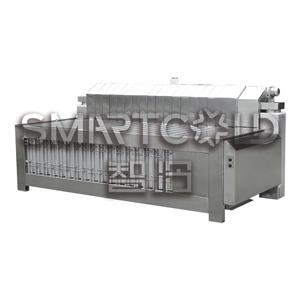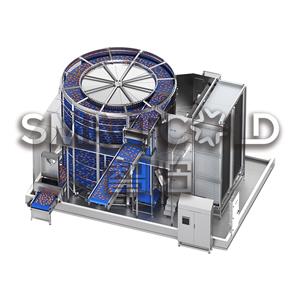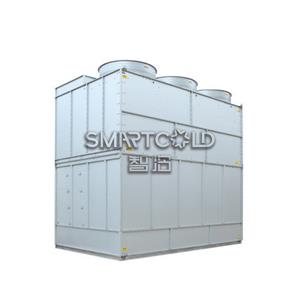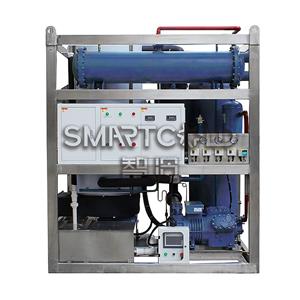The most complete refrigeration and air-conditioning science knowledge, after reading it carefully, you will gain a lot!
First, the basic knowledge of central air conditioning
1. What is a refrigerant and what is its working principle?
A working substance that transfers heat between the object to be cooled and the ambient medium, and finally transfers the heat from the object to be cooled to the ambient medium for the refrigeration cycle. Its working principle is that the refrigerant absorbs the heat of the cooled material in the evaporator and evaporates.
2. What is a refrigerant and what is its working principle?
The medium substance that transfers the cooling capacity of the refrigeration device to the cooled medium. For example, the commonly used air-conditioning chilled water is cooled in the evaporator and then transported over a long distance to cool the objects that need to be cooled.
3. What is sensible heat?
That is, the heat that does not change the form of a substance and causes its temperature to change is called sensible heat. Sensible heat changes can be measured with temperature measuring instruments.
4. What is latent heat?
The heat that causes the change of state of matter (also known as phase transition) without changing the temperature of the substance is called latent heat. Latent heat changes cannot be measured with temperature measuring instruments.
5. What are dynamic pressure, static pressure and total pressure?
When choosing an air conditioner or fan, three concepts of static pressure, dynamic pressure and total pressure are often encountered.
Static pressure (Pi): The pressure generated by the irregular movement of air molecules against the pipe wall is called static pressure. When calculating, the static pressure with absolute vacuum as the calculation zero is called absolute static pressure. The static pressure at which the atmospheric pressure is zero is called relative static pressure. The air static pressure in the air conditioner refers to the relative static pressure. It is positive when static pressure is above atmospheric pressure and negative when it is below atmospheric pressure.
Dynamic pressure (Pb): refers to the pressure generated when the air flows. As long as the air flows in the air duct, there will be a certain dynamic pressure, and its value will always be positive.
Total pressure (Pq): Total pressure is the algebraic sum of static and dynamic pressures: Pq=Pi + Pb. Total pressure represents the total energy possessed by 1m3 of gas. It can be positive or negative if atmospheric pressure is used as the starting point for the calculation.
Second, the classification of air conditioners
1. According to the purpose of use, what types of air conditioners can be divided into?
Comfortable air conditioner: It requires a suitable temperature, a comfortable environment, and no strict requirements for the adjustment accuracy of temperature and humidity.
Process air conditioning: There are certain requirements for the adjustment accuracy of the temperature, and the cleanliness of the air also has higher requirements. It is used in electronic device production workshop, precision instrument production workshop, computer room, biological laboratory, etc.
2. According to the air treatment methods, which categories can be divided into?
Centralized air conditioning: The air treatment equipment is concentrated in the central air conditioning room, and the treated air is sent to the air conditioning system of each room through the air duct. It is suitable for places with large areas, concentrated rooms, and relatively close heat and humidity loads in each room.
Semi-centralized air conditioning: An air conditioning system that has both central air conditioning and terminal units that process air. This kind of system is more complicated and can achieve higher adjustment accuracy. It is suitable for workshops and laboratories that have high requirements on air accuracy.
Localized air conditioners: Air conditioners in which each room has its own device to handle air, such as split-type air conditioners. It can also be a system composed of fan-coil-type air conditioners that supply cold and hot water in a centralized manner, and each room can adjust the temperature of its own room as needed.
3. What are the categories according to the cooling capacity?
Large air-conditioning units: such as horizontal assembled water-spraying and surface-cooled air-conditioning units, which are used in large workshops, cinemas, etc.
Medium-sized air-conditioning units: such as chillers and cabinet air-conditioning units, which are used in small workshops, computer rooms, venues, restaurants, etc.
Small Air Conditioning Units: Split type air conditioners for offices, homes, guest houses, etc.
4. According to the amount of fresh air, what categories can air conditioners be divided into?
Direct-flow system: The treated air is fresh air, which is sent to each room for heat and humidity exchange and then discharged to the outside without a return air duct.
Closed system: A system in which all the air processed by the air conditioning system is recirculated without supplemental fresh air.
Hybrid system: The air treated by the air conditioner is a mixture of return air and fresh air.
5. Classification by air supply speed?
High-speed system: the wind speed of the main air duct is 20-30m/s.
Low-speed system: the wind speed of the main air duct is below 12m/s.
3. Common terms of air conditioners
1. Nominal cooling capacity
In unit time, the heat removed from the space area or room by the air conditioner under the nominal cooling condition is called the nominal cooling capacity.
2. Nominal heating capacity
The heat released by the air conditioner to the space area or room under the nominal heating condition per unit time.
3. Energy Efficiency Ratio (EER)
The cooling capacity of unit motor input power. It reflects the ratio of cooling capacity to cooling power when the air conditioner is in cooling operation, in units of W/W. The national standard stipulates that the standard value of energy efficiency ratio of 2500W air conditioner is 2.65; the standard value of energy efficiency ratio of 2500W up to 4500W air conditioner is 2.70.
4. Performance parameters (COP)
The performance parameter COP value of the refrigeration compressor, that is, the cooling capacity per unit shaft power.
5. Commonly used air conditioner measurement units and conversions:
One kilowatt (KW) = 860 kcal (Kcal/h).
One calorie (Kcal/h) = 1.163 watts (w).
1 cold ton (USRT) = 3024 kcal (Kcal/h).
1 cold ton (USRT) = 3517 watts (W).
4. Common air conditioners
1. Water-cooled chiller
The water-cooled chiller belongs to the refrigeration unit part of the central air-conditioning system. Therefore, it is called a water-cooled unit, and the opposite of the water-cooled unit is called an air-cooled unit. The condenser of the air-cooled unit is cooled by forced ventilation heat exchange with the outdoor air.
2. VRV system
The VRV system is a variable refrigerant flow rate system. It is in the form of a set of outdoor units, consisting of a functional unit, a constant speed unit, and a frequency conversion unit. By connecting the outdoor unit system in parallel, the cooling pipes are concentrated into one pipe system, which can be easily matched according to the capacity of the indoor unit.
A maximum of one group of indoor units can be connected to 30 indoor units. The minimum capacity of a single indoor unit is 0.6KW and the maximum is 3.75KW. The capacity of the indoor unit can be adjusted within 50% to 130% of the capacity of the outdoor unit.
3. Modular machine
Based on the VRV system, the modular machine changes the traditional Freon pipeline into a water system, combines the indoor and outdoor units into a refrigeration unit, and changes the indoor unit into a fan coil unit. The refrigeration process is realized by the heat exchange of the refrigerant water. The modular machine gets its name because it can automatically adjust the number of starting units according to the cooling load requirements and realize flexible combination.
4. Piston chiller
Piston chiller is an integral refrigeration device specially used for air conditioning cooling purposes, which compactly assembles the piston refrigeration compressor and auxiliary equipment needed to realize the refrigeration cycle. Piston-type chillers are available in single-unit refrigeration from 60 to 900KW, suitable for medium and small projects.
5. Screw chiller
Screw chillers are large and medium-sized refrigeration equipment that provides chilled water. It is commonly used in air conditioning in national defense scientific research, energy development, transportation, hotels, restaurants, light industry, textiles and other departments, as well as chilled water for water conservancy and power projects. Screw chiller is a complete refrigeration system composed of screw refrigeration compressor unit, condenser, evaporator, automatic control components and instruments. It has the advantages of compact structure, small size, light weight, small footprint, convenient operation and maintenance, and stable operation, so it has been widely used.
6. Centrifugal chiller
Centrifugal chiller is a complete chiller composed of centrifugal refrigeration compressor and matching evaporator, condenser and throttling control device as well as electrical meter. The cooling capacity of a single unit ranges from 700 to 4200KW. It is suitable for large and extra large projects.
7. Lithium bromide absorption chiller
The lithium bromide absorption chiller is powered by thermal energy, uses water as refrigerant, and uses lithium bromide solution as absorbent to produce refrigerant water above 0°C, which can be used as a cold source for air conditioning or production processes. The lithium bromide absorption type uses thermal energy as the There are three common types of power, direct combustion type, steam type, and hot water type. The cooling capacity ranges from 230 to 5800KW, which is suitable for medium-sized, large-scale and extra-large projects.
5. Classification of central air-conditioning units
The central air-conditioning unit is the core part of the central air-conditioning system. Reasonable selection of units is crucial for a central air-conditioning project. According to the cooling method and structure classification of cold (hot) water unit, it can be divided into the following types.
6. 20 core components of refrigeration and air conditioning
1. Compressor
It is the core of the entire air conditioning system and the source of system power. The power of the entire air conditioner is provided by the compressor. Compressors According to the compression method, positive displacement compressors can be divided into two categories: piston type and rotary type. Specifically: piston type, sliding vane type, screw type, scroll type, centrifugal type, rotor type.
2. Condenser
The function is to cool the superheated vapor of the high-temperature and high-pressure refrigerant discharged from the compressor into a liquid or a gas-liquid mixture. It can be divided into three types: water-cooled, air-cooled, and water-air mixed cooling .
Water-cooled condenser: The heat of the refrigerant in the condenser is taken away by the cooling water. The cooling water can flow through at one time, or it can be recycled. When circulating, a cooling tower or cooling pool should be set up. Water-cooled condensers are divided into shell and tube type, casing type, plate type, spiral plate type and so on.
Air-cooled condenser: The heat released by the refrigerant in the condenser is taken away by the air, and the refrigerant is condensed in the tube. Such condensers include natural convection air-cooled condensers and forced convection air-cooled condensers. Usually, air-cooled condensers are also called air-cooled condensers.
Water and air combined cooling type: the heat released by the refrigerant in the condenser is taken away by the cooling water and air at the same time. When the cooling water is sprayed and evaporated outside the tube, it absorbs the latent heat of gasification to cool and condense the refrigerant in the tube, so the water consumption few.
3. Evaporator
The function is to use the liquid low-temperature refrigerant to evaporate easily under low pressure, convert it into vapor and absorb the heat of the cooled medium to achieve the purpose of refrigeration. Types of Evaporators: Evaporators are divided into two types: cooling liquid refrigerant, cooling air or other gases according to different cooling media.
Cooling liquid refrigerant: there are water tank type (submerged) evaporators (including vertical tube type, spiral tube type, snake type), plate evaporator, spiral plate evaporator, shell and tube evaporator (including horizontal evaporators) , dry evaporator) etc.
Among the cooling air evaporators: there are finned evaporators for air conditioners, air-air coolers (coolers) for refrigeration and refrigeration, and exhaust pipe evaporators.
4. Throttle mechanism
The high-pressure liquid from the condenser is throttled and depressurized, so that the liquid refrigerant vaporizes and absorbs heat at low pressure (low temperature). Therefore, it is an important component to maintain high pressure in the condenser and low pressure in the evaporator.
The throttling component can be divided into capillary tube and expansion valve according to the form. The capillary tube is used in smaller refrigeration equipment , such as the capillary tube installed between the condenser and the evaporator in the refrigerator, which is a kind of throttling mechanism.
Expansion valves are used in larger refrigeration equipment. The throttle mechanism used in large and medium-sized devices is a throttle valve. There are three commonly used throttle valves, namely manual expansion valve, float regulating valve and thermal expansion valve . Two types are self-adjusting throttle valves. Expansion valve can be divided into electronic expansion valve and thermal expansion valve according to the type of expansion .
5. Gas-liquid separator
It is installed at the inlet end of the compressor, mainly to prevent the low-pressure low-temperature steam returning to the compressor from carrying too many liquid droplets, to prevent liquid refrigerant from entering the compressor cylinder, and to prevent liquid hammer. The separator also has filtration, oil return, liquid storage, etc. Function.
When using the gas-liquid separator, pay attention to:
1. As close as possible to the compressor;
2. In the reversing system, the gas-liquid separator should be installed between the reversing valve and the compressor;
3. Correctly install the inlet (from the evaporator) and the outlet (to the suction port of the compressor);
4. It must be installed upwards;
6. Fan
The fan is a combination of AC single and three-phase induction motors and impellers. Fans are divided into axial fans and centrifugal fans.
Fans include two series of fixed speed and variable speed. Fans are divided into metal fan blades, plastic fan blades and metal cast fan blades, etc. There are many types of blades.
7. Reservoir
The high-pressure liquid accumulator (also called liquid accumulator) in the refrigeration system is installed between the condenser and the expansion valve. There are many forms of liquid accumulators, one-way and two-way; vertical and horizontal. points . _ Its functions can be summarized in several aspects:
Storing the condensate of the condenser: Avoid the accumulation of condensate in the condenser to reduce the heat transfer area and affect the heat transfer effect of the condenser.
Adapt to the demand for the supply quantity due to the load change of the evaporator: when the evaporation load increases, the supply quantity also increases, which is replenished by the liquid storage in the liquid accumulator; when the load becomes smaller, the required liquid quantity also becomes smaller, and the excess liquid is stored in in the reservoir.
As a liquid seal between the high and low pressure sides in the system: because the liquid outlet pipe is inserted under the liquid surface, it can prevent the steam and non-condensable gas on the high pressure side from entering the low pressure side. At the same time, the accumulator also acts as a filter and silencer.
8. Oil separator
Installed between the compressor and the condenser, its working principle is: the exhaust gas of the compressor is a mixture of refrigerant and lubricating oil, which is decelerated through the larger cavity of the oil separator, and the misty oil will gather On the impacted surface, after gathering into larger oil droplets, it flows to the bottom of the oil separator and returns to the compressor through the oil return device.
9. Gas-liquid separator
The gas-liquid separator is installed at the air inlet of the compressor, and the function of the gas-liquid separator is to prevent the liquid refrigerant from being sucked into the air inlet of the compressor to cause liquid shock to damage the compressor.
The four-way reversing valve is suitable for heat pump air conditioning systems such as central air conditioners and unit air conditioners. It is used to switch the circulation path of the refrigerant to achieve the purpose of cooling and heating.
12. Water pump
It is a tool used to accelerate the flow of water to achieve the effect of enhancing the heat exchange of water in the heat exchanger.
13. For water flow switch
It is used to control or cut off the flow of fluid in the pipeline. When the fluid flow reaches the set value, the switch will automatically cut off (or connect) the circuit.
15. Differential pressure controller
Used as the control of pressure difference, when the pressure difference reaches the set value, the switch will automatically cut off (or connect) the circuit.
16. Temperature controller
It is used for the control or protection of the unit. When the temperature reaches the set value, the switch will automatically cut off (or connect) the circuit. The temperature control is often used, and the temperature of the water tank is used to control the start and stop of the unit. There are also some like antifreeze that require the use of a temperature controller.
17. Sight glass
Sight glass is used to indicate:
1. The condition of the refrigerant in the liquid pipeline in the refrigeration unit;
2. The water content in the refrigerant;
3. The flow of lubricating oil from the oil separator in the oil return line. Some sight glasses have an indicator that changes its color to indicate the water content in the refrigerant. (green means dry, yellow means wet).
18. Solenoid valve
Solenoid valve is a shut-off valve that automatically switches on and off by electromagnetic force. In refrigeration and air conditioning devices, solenoid valves are commonly used to control system refrigerants. It can be applied to various gases, liquid refrigerants, lubricating oil and other media.
19. Expansion tank
The role of the expansion tank:
The volume of water changes due to temperature changes, and the expansion tank is used to store this part of the expansion water;
It acts as a constant voltage regulator for the system.
Part of the water can be compensated for the system.
20. Cooling tower
A cooling tower is a device that uses water as a circulating coolant to absorb heat from a system and discharge it into the atmosphere to reduce the water temperature. Its cooling is to use water and air flow to exchange cold and heat to generate steam, and the volatilization of steam takes away heat to achieve evaporative heat dissipation, convection heat transfer and radiation heat transfer to dissipate waste heat generated in refrigeration and air conditioning to reduce water temperature. Evaporative heat dissipation To ensure the normal operation of the system, the device is generally barrel-shaped, so it is called a cooling tower.




